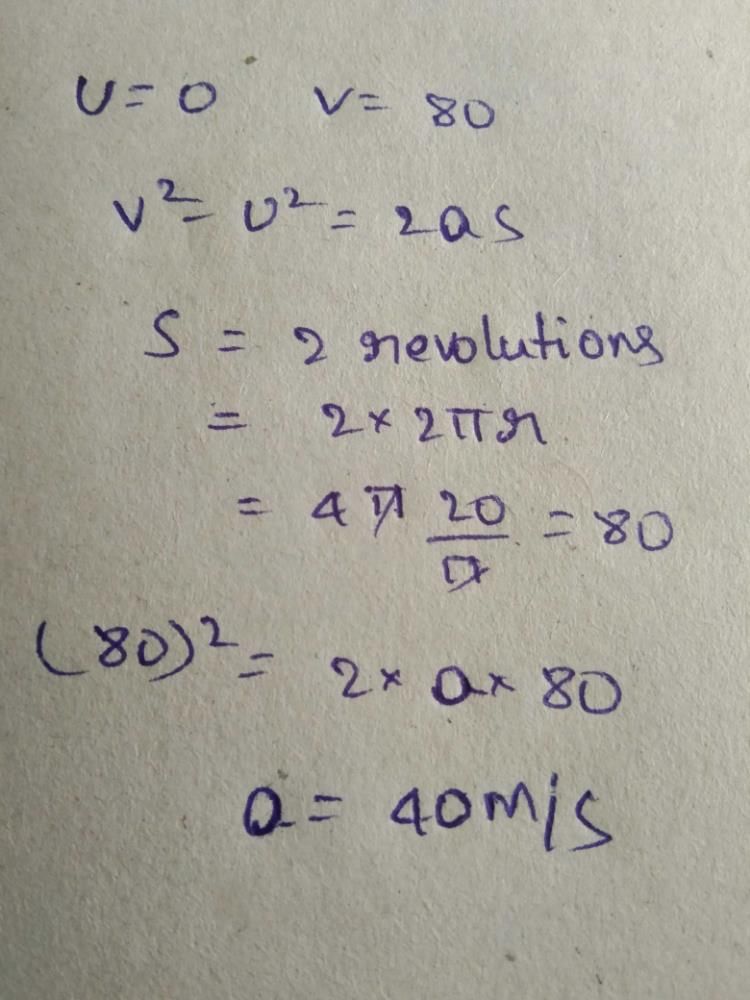NEET Exam > NEET Questions > A particle moves along a circle of radius (20...
Start Learning for Free
A particle moves along a circle of radius (20/π)m with constant tangential acceleration. If the velocity of the particle is 80m/s at the end of the second revolution after motion has begun, the tangential acceleration is-
( a)-160πm/s²
(b)-40πm/s²
( c)-40m/s²
( d)-640πm/s².
Can you explain this?
( a)-160πm/s²
(b)-40πm/s²
( c)-40m/s²
( d)-640πm/s².
Can you explain this?
Most Upvoted Answer
A particle moves along a circle of radius (20/π)m with constant tangen...
At first we should calculate the angular accelaration using the formula,w*2 euals w0^2-2ax where x equals 4theta,then using a equals to alpha*r where alpha is angular acc*n and r is the radius of the circle ,you will get the result 40m/s.
Community Answer
A particle moves along a circle of radius (20/π)m with constant tangen...

Attention NEET Students!
To make sure you are not studying endlessly, EduRev has designed NEET study material, with Structured Courses, Videos, & Test Series. Plus get personalized analysis, doubt solving and improvement plans to achieve a great score in NEET.

|
Explore Courses for NEET exam
|

|
Similar NEET Doubts
A particle moves along a circle of radius (20/π)m with constant tangential acceleration. If the velocity of the particle is 80m/s at the end of the second revolution after motion has begun, the tangential acceleration is-( a)-160πm/s² (b)-40πm/s²( c)-40m/s²( d)-640πm/s². Can you explain this?
Question Description
A particle moves along a circle of radius (20/π)m with constant tangential acceleration. If the velocity of the particle is 80m/s at the end of the second revolution after motion has begun, the tangential acceleration is-( a)-160πm/s² (b)-40πm/s²( c)-40m/s²( d)-640πm/s². Can you explain this? for NEET 2024 is part of NEET preparation. The Question and answers have been prepared according to the NEET exam syllabus. Information about A particle moves along a circle of radius (20/π)m with constant tangential acceleration. If the velocity of the particle is 80m/s at the end of the second revolution after motion has begun, the tangential acceleration is-( a)-160πm/s² (b)-40πm/s²( c)-40m/s²( d)-640πm/s². Can you explain this? covers all topics & solutions for NEET 2024 Exam. Find important definitions, questions, meanings, examples, exercises and tests below for A particle moves along a circle of radius (20/π)m with constant tangential acceleration. If the velocity of the particle is 80m/s at the end of the second revolution after motion has begun, the tangential acceleration is-( a)-160πm/s² (b)-40πm/s²( c)-40m/s²( d)-640πm/s². Can you explain this?.
A particle moves along a circle of radius (20/π)m with constant tangential acceleration. If the velocity of the particle is 80m/s at the end of the second revolution after motion has begun, the tangential acceleration is-( a)-160πm/s² (b)-40πm/s²( c)-40m/s²( d)-640πm/s². Can you explain this? for NEET 2024 is part of NEET preparation. The Question and answers have been prepared according to the NEET exam syllabus. Information about A particle moves along a circle of radius (20/π)m with constant tangential acceleration. If the velocity of the particle is 80m/s at the end of the second revolution after motion has begun, the tangential acceleration is-( a)-160πm/s² (b)-40πm/s²( c)-40m/s²( d)-640πm/s². Can you explain this? covers all topics & solutions for NEET 2024 Exam. Find important definitions, questions, meanings, examples, exercises and tests below for A particle moves along a circle of radius (20/π)m with constant tangential acceleration. If the velocity of the particle is 80m/s at the end of the second revolution after motion has begun, the tangential acceleration is-( a)-160πm/s² (b)-40πm/s²( c)-40m/s²( d)-640πm/s². Can you explain this?.
Solutions for A particle moves along a circle of radius (20/π)m with constant tangential acceleration. If the velocity of the particle is 80m/s at the end of the second revolution after motion has begun, the tangential acceleration is-( a)-160πm/s² (b)-40πm/s²( c)-40m/s²( d)-640πm/s². Can you explain this? in English & in Hindi are available as part of our courses for NEET.
Download more important topics, notes, lectures and mock test series for NEET Exam by signing up for free.
Here you can find the meaning of A particle moves along a circle of radius (20/π)m with constant tangential acceleration. If the velocity of the particle is 80m/s at the end of the second revolution after motion has begun, the tangential acceleration is-( a)-160πm/s² (b)-40πm/s²( c)-40m/s²( d)-640πm/s². Can you explain this? defined & explained in the simplest way possible. Besides giving the explanation of
A particle moves along a circle of radius (20/π)m with constant tangential acceleration. If the velocity of the particle is 80m/s at the end of the second revolution after motion has begun, the tangential acceleration is-( a)-160πm/s² (b)-40πm/s²( c)-40m/s²( d)-640πm/s². Can you explain this?, a detailed solution for A particle moves along a circle of radius (20/π)m with constant tangential acceleration. If the velocity of the particle is 80m/s at the end of the second revolution after motion has begun, the tangential acceleration is-( a)-160πm/s² (b)-40πm/s²( c)-40m/s²( d)-640πm/s². Can you explain this? has been provided alongside types of A particle moves along a circle of radius (20/π)m with constant tangential acceleration. If the velocity of the particle is 80m/s at the end of the second revolution after motion has begun, the tangential acceleration is-( a)-160πm/s² (b)-40πm/s²( c)-40m/s²( d)-640πm/s². Can you explain this? theory, EduRev gives you an
ample number of questions to practice A particle moves along a circle of radius (20/π)m with constant tangential acceleration. If the velocity of the particle is 80m/s at the end of the second revolution after motion has begun, the tangential acceleration is-( a)-160πm/s² (b)-40πm/s²( c)-40m/s²( d)-640πm/s². Can you explain this? tests, examples and also practice NEET tests.

|
Explore Courses for NEET exam
|

|
Suggested Free Tests
Signup for Free!
Signup to see your scores go up within 7 days! Learn & Practice with 1000+ FREE Notes, Videos & Tests.

























